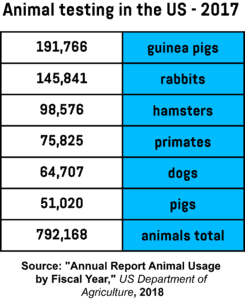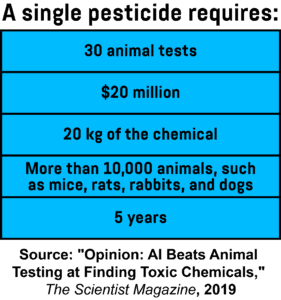- A move away from animal testing
- Organs on chips mimic the functioning of human organs
- Computer modeling accurately predicts how the human body responds to certain chemicals
- Lab-grown skin models are replacing animal testing in the cosmetics industry
- How close are we to ending animal testing?

Animal testing has long been a staple of laboratory research. Whether they’re used by the cosmetics industry to test the safety of new beauty products, study the effects of chemicals in toxicology, determine the safety and toxicity of drugs in pharmacological research, or perform experiments in biomedical research, animals continue to play an important role in many different fields.
According to a report published by the US Department of Agriculture, 792,168 animals were subjected to testing in various government, university, and private research facilities across the country in 2017. This includes 191,766 guinea pigs, 145,841 rabbits, 98,576 hamsters, 75,825 primates, 64,707 dogs, and 51,020 pigs.
A move away from animal testing
However, due to growing concerns for animal welfare and mounting evidence that the results of animal testing aren’t always applicable to humans, researchers are increasingly turning to alternative testing methods that don’t involve animals. “More than 90% of drugs entering clinical trials fail, despite positive results in preclinical animal tests. Most of these drugs fail for reasons of toxicity and poor efficacy that were not detected in animals,” explains Dr Jarrod Bailey, the senior research scientist at Cruelty Free International. Similarly, just because something is toxic to animals, doesn’t necessarily mean it will also be toxic to humans. “Substances that might be safe and effective in humans may be rejected or delayed at animal trials due to animal toxicity, potentially hindering the development of effective treatments for humans,” adds Christina Dodkin, the research director at Animal Defenders International (ADI).
Considering that even small genetic differences between humans and animals have been shown to affect the progression of a disease and response to treatment, animal biology is simply too different from our own to accurately predict how the human body will respond to certain products or chemicals. Furthermore, as we often use animals to test treatments for diseases that don’t occur naturally in them, researchers are forced to create artificial versions of the diseases, which brings into question the value of the obtained results. Last but not least, test results can also be affected by the animal laboratory environment, where differences in the animal’s age, sex, diet, or even their bedding material are known to produce different results for the same drug. Thankfully, there may be a better way. In recent years, a number of innovative, non-animal testing methods have appeared that could not only bring an end to animal cruelty, but also provide results that are more relevant to human health.
Organs on chips mimic the functioning of human organs
One of the most promising alternatives to animal testing involves microchips lined with living human cells and tissues, which allows them to mimic the mechanical and molecular characteristics of real human organs, such as the heart, kidney, lungs, liver, and intestines. “An Organ-Chip is a living, micro-engineered environment that re-creates the natural physiology and mechanical forces that cells experience within the human body. Our Organ-Chips are a ‘home away from home’ for the cells to live just as they do in the human body,” explains Geraldine A. Hamilton, the president and chief scientific officer of Emulate Inc., one of the companies working on this technology.
These miniature versions of human organs can be used in place of animals in disease research, drug testing, and toxicity testing. What’s even more important is that they’ve proven more accurate than animal testing in replicating human physiology, diseases, and drug responses, delivering results that are more relevant to humans. “Our Organ-Chips work within the Human Emulation System that provides a real-time window into the inner workings of human biology and disease – offering researchers a new technology designed to predict human response with greater precision and detail than today’s cell culture or animal-based experimental testing,” adds Hamilton. The ultimate goal is to combine multiple organs on chips to create a Patient-on-a-Chip that would be able to mimic the entire human body.
Lab-grown skin models are replacing animal testing in the cosmetics industry
In 2013, the European Union banned animal testing on all cosmetic products that are produced and sold within the EU. In the following years, a number of other countries introduced similar bans, forcing cosmetics companies to look for alternative tools that will allow them to test the functionality and safety of their new cosmetics products. “We need alternatives to animal models,” says Dr. Anja Krattenmacher, a postdoctoral scientist in the sector for performance materials at Merck, a company that develops healthcare, life sciences, and performance materials. “Besides ethical considerations, it is also important to highlight that animal skin differs from human skin and these anatomical differences might influence product absorption and penetration.”
As an alternative to animal testing, Merck developed 3D skin models made from fibroblasts and keratinocytes. The fibroblasts, a type of cell that’s responsible for making the extracellular matrix and collagen, are first embedded into an extracellular matrix to build the dermis, the second, thicker layer of the skin that lies below the epidermis. Then, to build the epidermis as well, the researchers introduce keratinocytes, a type of cell that produces keratin. They then induce cell differentiation by exposing the models to the air, which can take between 10 and 14 days. Once cell differentiation is complete, the researchers can finally add cosmetic products and perform various tests.
These 3D skin models have a structure that’s comparable to that of real human skin, allowing them to produce results that are more relevant to humans than animal testing. “Three-dimensional skin models have great potential,” adds Krattenmacher. “Results are reproducible and can be often translated to humans, which lowers the need for animal testing of cosmetics while giving fundamental insights into cellular interactions within tissue-like structures. These models will play an important role not only for the cosmetic industry, but also in medical research.”
Computer modeling accurately predicts how the human body responds to certain chemicals
In recent years, researchers have also been working on developing sophisticated computer models capable of predicting the effects of certain chemicals on the human body with a high degree of accuracy. The traditional approach that involves testing the toxicity of a particular substance on animals is usually very expensive and time-consuming. For example, a single pesticide requires 30 animal tests, which costs around $20 million and requires 20 kg of the chemical and more than 10,000 animals, such as mice, rats, rabbits, and dogs. The whole process takes about five years. As an alternative, the researchers from the Center for Alternatives to Animal Testing (CAAT) at Johns Hopkins University have developed a computer program that uses artificial intelligence (AI) to process existing data on chemical toxicity and deliver new insights.

The researchers first created a comprehensive database that consists of 800,000 toxicological studies on more than 10,000 industrial chemicals. This database was then used to feed an advanced predictive algorithm capable of determining the toxicity of any chemical without the need to subject animals to cruel testing. Instead, the program employs the power of big data and a machine learning method called transfer learning, which uses information obtained from one problem to solve another, related problem. Based on the knowledge that similar chemicals have similar properties, the program creates a map of the chemical universe by placing similar chemicals close to one another. Now, when researchers want to place a new chemical on the map, they can simply take a look at its closest neighbours to determine whether it will have any harmful health and environmental effects.
In the next step, the researchers joined forces with Underwriters Laboratories (UL), a global safety consulting and certification company, to increase the size of the database to more than 10 million chemical structures. They then used an Amazon cloud server to analyse the similarities and differences between all 10 million chemicals and place them on the chemical map. When applied to 190,000 chemicals already classified based on previous animal tests, the algorithm was able to correctly predict the toxicity of a particular chemical 87 per cent of the time. In comparison, repeat animal tests are correct just 70 per cent of the time. In addition to reducing the need for animal testing and preventing unneccessary loss of animal life, using AI to determine toxicity can also drastically reduce costs by allowing chemists to identify potential issues before the compounds are even synthesised and offer less toxic alternatives.
How close are we to ending animal testing?
Animal testing has come under increased scrutiny in recent years, with the public urging researchers to find alternative, non-animal testing methods and spare lab animals unnecessary pain and suffering. Besides ethical concerns, there’s a growing body of evidence that suggests the results of animal testing may not be directly applicable to humans, due to major differences between human and animal physiologies.
In recent years, a number of innovative testing methods that don’t involve animals have appeared on the market, ranging from microchips that mimic the functioning of real human organs to 3D skin models to computer models that use artificial intelligence to predict the toxicity of a particular chemical. In addition to being cheaper and faster than animal testing, these alternative testing methods also produce results that are more relevant to human health.
However, while these new methods have replaced animal testing in the cosmetics industry and toxicology to a certain degree, there are still certain areas where animal models will remain necessary for the foreseeable future. “The major problem in developing artificial organ systems is to gain the whole complexity of a living organism in vitro,” explains Florian Schmieder, a researcher at the Fraunhofer Institute for Material and Beam Technology. “The problem here is to emulate the kinetics and dynamics of the human body in a really predictive way.” Even though solutions like organs on chips have shown a great deal of promise, they’re still not advanced enough to allow us to replace animal models altogether. They do, however, offer hope that animal testing will one day be a thing of the past.
Share via:


